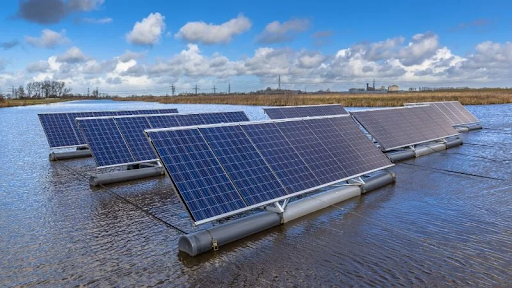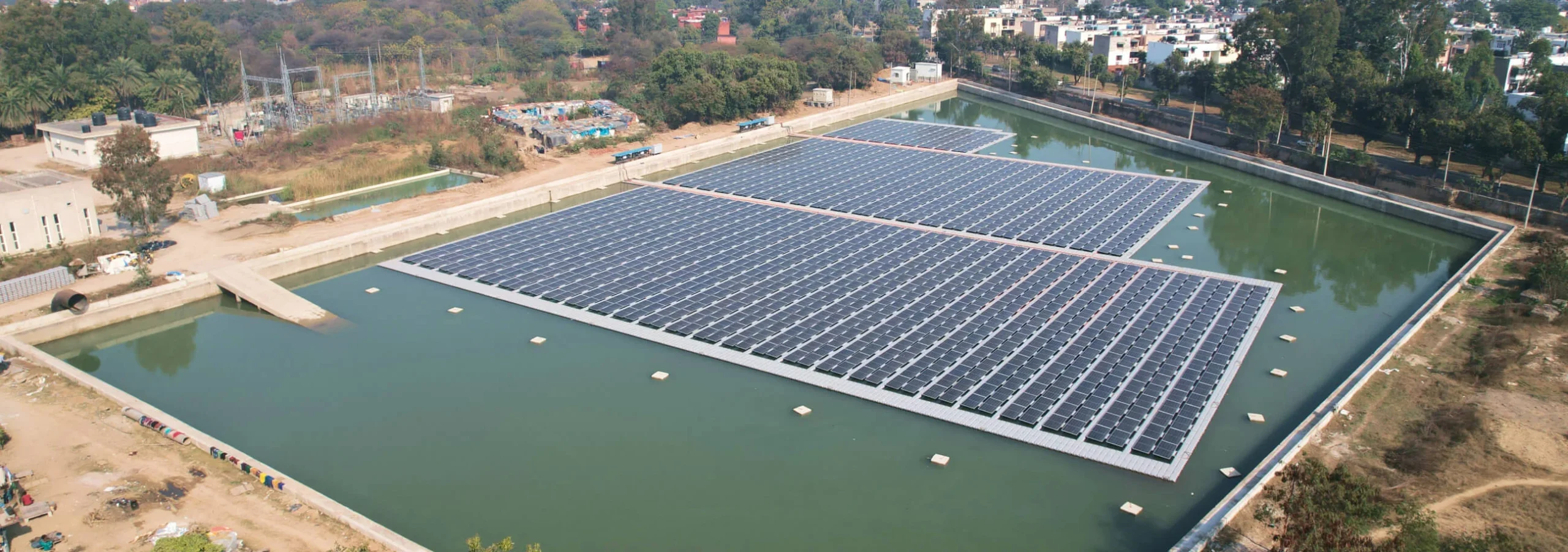India is fast embracing renewable energy to address its escalating demand for power while causing least damage to the environment. Innovational solutions amidst this are floating solar plants in India that are becoming a game-changer. By fixing solar panels over freshwater reservoirs, irrigation canals, and lakes, India is making optimum use of idle spaces to produce clean power.
EPC leaders like Hartek are pioneering floating solar installation projects across the country, enabling large-scale adoption of sustainable power systems while addressing land scarcity challenges.
What are Floating Solar Plants?
One such technology is the floating solar plant or floating photovoltaic (FPV) system. It comprises solar panels that are installed on floating structures. Like ground-mounted conventional solar installations, the floating photovoltaic system gets connected to the grid using transformers and inverters.
The major benefits of floating solar systems are:
- Less area needed.
- Improved panel efficiency through the natural cooling provided by the water.
- Less evaporation loss from reservoirs.
- Minimal ecological disruption if properly planned
India, which has several reservoirs and freshwater basins, is the most suitable nation to develop floating solar power projects and has renewable energy goals that are ambitious.

Why Floating Solar Power in India Matters Now More Than Ever
- Land Shortage
Urban and agricultural land is increasingly limited in India. Floating solar projects solve this challenge by using water surfaces, preserving land for agriculture or development purposes.
- Increased Energy Production
The naturally cooling photovoltaic panels also boost efficiency by between 10-15% when compared to the standard solar installations.
- Environmental Advantages
Floating solar reduces water evaporation and algae growth in reservoirs, creating a dual benefit for water conservation and clean energy production.
4. Cost-Efficiency
Though the initial investment is slightly higher than that of ground-mounted systems, the lower cost of land procurement and greater efficiency will enhance the long-run returns.
- Scalability & Flexibility
Floating solar systems are modular, allowing easy expansion as demand grows. Projects can range from a few hundred kilowatts to hundreds of megawatts, making them suitable for small lakes or large reservoirs.
Main Components of Floating Solar Systems
- Floating Structure
The floating deck has spaces for accommodating solar panels, resists wind and water current, and provides stability. Durable materials such as HDPE and polypropylene are also popular.
- Solar Panels
High-efficiency photovoltaic panels generate electricity by converting sunshine. Panels are optimally pitched for maximum exposure to the sun.
- Inverter & Transformer
The DC current from panels is converted to AC by inverters and supplied to the grid by transformers so that it can easily be synchronized by the local power supply.
- Anchoring and Mooring Systems
These systems secure the floating solar installation to the reservoir floor while accommodating water level fluctuations.
Use Cases: Where Floating Solar Systems Excel
- Irrigation Reservoirs – Minimizing evaporation while powering rural networks.
- Hydropower Dams – Supplementing the current hydropower infrastructure for hybrid power generation.
- Urban Lakes & Ponds – Power generation by using city ponds and lakes without using any land.
- Industrial Water Bodies – Providing industrial parks and factories with renewable energy from the site.
Issues & Considerations
Though floating solar power holds great promise, technical and environmental factors are involved:
- Water Quality & Ecology: Appropriate planning minimizes disruption for aquatic life.
- Anchoring & Maintenance: Moorings are exposed to wave action, wind, and fluctuating water levels.
- Capital Cost: Floating solar needs dedicated structures, hence slightly higher initial cost.
- Grid Connectivity: Efficient transmission infrastructure plays a central role in directing power into the local grid.
India Floating Solar Projects: Present Situation
India has commissioned around 400–500 MW (0.4–0.5 GW) of floating solar power projects so far, with states such as Kerala, Telangana, Madhya Pradesh, Tamil Nadu, and Gujarat leading the charge. Major projects include:
- 100 MW floating solar project at Ramagundam (Telangana)
- 101.6 MW floating solar project over the Kayamkulam backwaters (Kerala)
- 92 MW floating solar project at Haripad (Kerala)
- 90 MW floating solar project over the Omkareshwar Reservoir (Madhya Pradesh)
Because of the efforts by the government through the National Solar Mission and higher private industry participation, floating solar installation will see exponential growth.
Advantages Over Ground-Mounted Systems
| Feature | Floating Solar | Ground-Mounted Solar |
| Land Use | Uses water surfaces, no land acquisition needed | Requires large land areas |
| Efficiency | Natural cooling, higher output | Can overheat, reducing efficiency |
| Water Conservation | Reduces evaporation | No impact |
| Environmental Impact | Minimal if planned well | Can impact soil & biodiversity |
| Scalability | Modular, easy to expand | Land availability limits growth |
Conclusion:
Floating solar plants in India are more than a technological innovation, they are a strategic solution to land scarcity, climate change, and rising energy demand. By integrating modular floating solar systems, state-of-the-art inverters, and optimized anchoring systems, India can harness its abundant water resources to generate clean, renewable energy.
Floating solar is a scalable, efficient, and green solution for EPC contractors, developers, and utilities to power India’s future. Innovators like Hartek are already setting benchmarks in floating solar power projects, helping the country transition seamlessly to sustainable energy.
FAQs
Q1. How is floating solar distinct from the conventional type of solar?
Floating solar is installed on water surfaces, offering higher efficiency and conserving land, while traditional solar is ground-mounted on land.
Q2: Is the floating solar system possible for all the waters?
Yes, but it needs careful assessment to prevent environmental effects and stable fixing.
Q3: How much energy can a floating solar power plant generate?
Output is a function of panel capacity, water surface area, and available sunshine. Projects vary from the kilowatt-level to hundreds of megawatts.
Q4. Is maintenance challenging for floating photovoltaic installations?
The maintenance is simple but needs dedicated access to the water surfaces. It needs regular cleaning, anchor check-ups, and checking the inverters.
Q5: Can floating solar projects reduce water evaporation?
Yes, covering the water surfaces minimizes exposure to the sun and wind while conserving water and producing electricity.





